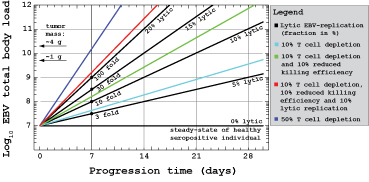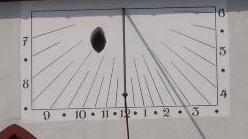
Transplantation immunology and virology
Organ transplantation has been called "the greatest therapeutic advance" of the second half of the 20th century. The immune system of transplant recipients is deliberately suppressed to prevent rejection of the allograft. This allows latent pathogens to take advantage of the situation and to replicate more or less unchecked. The allograft may be lost by (immunological) rejection, inflammation or by viral destruction. For the clinician, quantification of the efficacy of interventions is crucial. Mathematical models can help to optimize and streamline clinical investigations from basic research to application and patient management. Risk assessment of graft rejection versus infection in patients with compromised immunity is another part of this research field.
 Graphical tumor mass calculator of Graphical tumor mass calculator ofan Epstein-Barr virus infected host en route to PTLD. Subsidiary lines are motivated by the lines a shadow stick projects on a sundial (see below). For details see: Funk et al., 2007, The Lancet Infectious Diseases. |
Translational research
Translational research refers to the transfer of knowledge from basic research to clinics and bedside. This includes the development of tools that optimize and streamline clinical investigations from discovery to application. I develop innovative computational tools for patient data analysis, efficacy measurements, and predictors of disease progression.
Darwinian medicine
While classical medical research focuses on the immediate reasons of a disease, Darwinian medicine also considers evolutionary aspects. It is not always clear whether ‘disease’ is caused by the pathogen itself, by the host to contol a pathogen, or whether it is neither in advantage for the host nor for the pathogen.
 |  |
| From where inspiration comes. Left: sundial on the SW wall of the gothic Peterskirche, Basel. Right: sundial on the SW wall of a house at the Leonhardskirchplatz, Basel. | |
